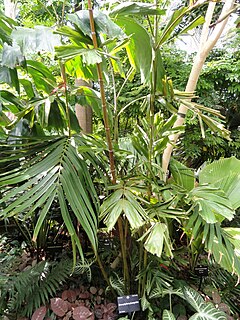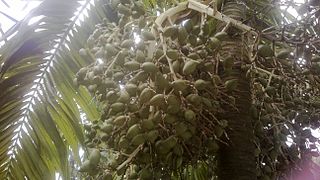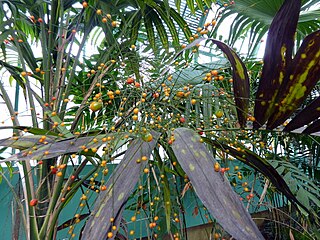
Acanthophoenix is a genus of flowering plants in the palm family from the Mascarene Islands in the Indian Ocean, where they are commonly called palmiste rouge. A genus long in flux, three species are currently recognized, though unsustainable levels of harvesting for their edible palm hearts have brought them all to near extinction in habitat. They are closely related to the Tectiphiala and Deckenia genera, differing in the shape of the staminate flower. The name combines the Greek words for "thorn" and "date palm".
Barcella is a monotypic genus of flowering plant in the palm family found in the States of Amazonas and Roraima in northwestern Brazil. The only known species is Barcella odora which is used by the Brazilian peoples in construction and for various thatched goods.
Brassiophoenix is a monoecious genus of flowering plant in the palm family found in Papua New Guinea. Of the two similar species, one is more common in cultivation and was mistakenly identified as Brassiophoenix schumannii. In 1999, Zona and Estig showed that the commonly cultivated species was instead the type species Brassiophoenix drymophoeoides. The two species are distinguished by their separated geographical locations and minor differences in fruit form. The genus name is a combination of the surname Brass, honoring the first collector L.J. Brass, and Phoenix, another palm genus.

Calyptrocalyx is a monoecious genus of flowering plant in the palm family found in Papua New Guinea and the nearby Maluku Islands. Ranging from small to large, the palms in this genus are increasingly found in cultivation owing largely to their purple, red, and orange colored, new foliage. At least 26 species have been described while others, known only by local names, have not yet received a taxonomic account. Palms formerly classified within Paralinospadix have been incorporated into this genus. It is named from 2 Greek words meaning 'covered' and 'calyx'.

Actinorhytis is a monotypic genus of flowering plant in the palm family found in Oceania and southeast Asia. The lone species, Actinorhytis calapparia is a rain forest inhabitant and has very large fruit. The genus name is from two Greek words meaning 'ray' and 'fold' which describe the endosperm of the seed.

Dictyocaryum is a monoecious genus of flowering plant in the palm family found in South America. It is closely related to the genus Iriartea; they are commonly called araque or palma real. As many as eleven species have been described but this number is reduced to three in most current accounts. The genus name translates from two Greek words meaning "net" and "nut", describing the thick network of raphe fibers around the seed.
Cyphokentia macrostachya is a species of palm endemic to New Caledonia.

Heterospathe is a monoecious genus of flowering plant in the palm family found in Oceania, where it is called sagisi palm. With 39 species, Heterospathe is named from a Greek combination of "various" and "spathe", which describes the two distinct bract types.

Hydriastele is a diverse and widespread genus of flowering plant in the palm family found throughout Australia and New Zealand, Melanesia, Polynesia, and Southeast Asia. It consisted of just nine species until 2004, when molecular research, supported by morphologic similarities, led taxonomists to include the members of the Gulubia, Gronophyllum, and Siphokentia genera. 48 species are now recognized, of which 38 are new combinations, two are new names and one is a new species. It is named in Greek, combining "hydriad", a water nymph in mythology, and "column".

Lepidorrhachis is a monotypic genus of flowering plant in the palm family restricted to Lord Howe Island. The genus name for the single, monoecious species, Lepidorrhachis mooreana, comes from two Greek word meaning "scale" and "rachis", and the epithet honors Charles Moore, first director of the Sydney Botanical Gardens. The common name is Little Mountain Palm.

Ceratolobus is a dioecious genus of flowering plant in the palm family found in Southeast Asia, commonly called rotan. They are only differentiated from close relatives like Korthalsia, Calamus, and Daemonorops by leaf sheath appendages or inflorescence variations. The Greek genus name combines "horn" and "capsule".

Oraniopsis is a monotypic genus of flowering plant in the palm family from Queensland, Australia, where the only known species, Oraniopsis appendiculata, grows in mountainous rain forest. Dioecious and extremely slow growing, the name means "similar to Orania" and the Latin epithet translates to "appendaged".
Plectocomiopsis is a dioecious genus of flowering plant in the palm family found in Indochina, Malaysia, Borneo and Sumatra. Hapaxanthic and armed with spines, they are a climbing rattan, closely related to the Myrialepis palms. The name is Greek for "similar to Plectocomia", another close relative.
Pogonotium is a dioecious genus of flowering plant in the palm family found in Malaysia and Borneo. Its close relatives are climbing rattans and while partially armed with climbing apparatus, its habit is sprawling and leaning but not effective climbing. The reduced inflorescence nestled between the auricles is unusual and distinguishes it from similar relatives like Calamus, Daemonorops and Ceratolobus. The name is Greek meaning "bearded".

Allagoptera caudescens is a species of flowering plant in the palm family endemic to Brazil, where it is known as buri palm. The name combines the Greek words for "many" and "anther" with the name of another palm genus Cocos, and the epithet is Latin for "bearlike", referring to the hairy tomentum. It was formerly classified as Polyandrococos caudescens, the only species in the genus Polyandrococos.

Ptychococcus is a monoecious genus of flowering plant in the palm family from New Guinea and the Solomon Islands. They are closely related to Ptychosperma, only differentiated by the seed shape and endocarp type. The name is a combination of the Greek for "fold" and the Latin for "berry".
Retispatha is a rare, monotypic genus of flowering plant in the palm family endemic to Borneo, where the sole species, Retispatha dumetosa, is known as wi tebu bruang or "the bear's sugar cane". The name combines Latin and Greek words meaning "network" and "spathe", and the species epithet means "bushy". While classified with other rattans, they retain only superficial climbing organs; they sprawl and lean but are not true climbers.
Sclerosperma is a monoecious genus of flowering plant in the palm family found in Africa where three species are known. Having no obvious relatives, it does resemble the Madagascar native Marojejya though a detailed study of Madagascar's palms is required to determine if any true relationship exists. The lack of relatives, and its interesting qualities, indicate, at one time, the existence of a diverse African palm flora. The name is from two Greek words meaning "hard" and "seed".

Synechanthus is a monoecious genus of flowering plant in the palm family found in Mexico, Central and South America. Commonly called bola, palmilla, or jelly bean palm, they are closely related to members of Chamaedorea, only distinguished by their flower and fruit form. The Greek genus name is a combination of "united" and "flower".

Cyphophoenix alba is a species of palm in the family Arecaceae endemic to New Caledonia. It was previously placed in the genus Veillonia.













